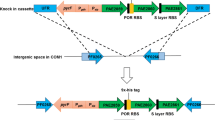Abstract
An NADP+ —dependent reversible 3-hydroxycarboxylate oxidoreductase present in Clostridium tyrobutyricum has been purified. As judged by gel electrophoresis the enzyme was pure after a 940-fold enrichment by four chromatographic steps. Its molecular mass was estimated to be 40–43 kDa. The enzyme was most active at pH 4.5 in the reduction of 3-oxobutyrate. Other substrates were 3-oxovalerate, 3-oxocaproate, 3-oxoisocaproate and 4-chloro-3-oxobutyrate. Except for the latter all substrates were converted enantioselectively to (S)-3-hydroxy acids in the presence of NADPH. 4-Chloro-3-oxobutyrate was reduced to the (R)-3-hydroxy acid. The specific activity of the enzyme was about 1400 μmol min−1 mg−1 protein for the reduction of 3-oxobutyrate at pH 5.0. The Michaelis constant (K m) values for 3-oxobutyrate, 3-oxovalerate and 3-oxocaproate were determined to be 0.22, 1.6 and 3.0 mM, respectively. The K m values for dehydrogenation of (S)-3-hydroxybutyrate, (S)-3-hydroxyvalerate and (S)-3-hydroxycaproate were found to be 2.6, 1.1 and 5.2 mM, respectively. The identity of 43 of the first 45 N-terminal amino acid residues has been determined. So far such enzyme activities have been described in eucaryotes only.
Similar content being viewed by others
References
Bader J, Simon H (1980) The activity of hydrogenase and enoate reductase in two Clostridium species, their interrelationship and dependence on growth conditions. Arch Microbiol 127:279–287
Bergmeyer HU, Gawehn K, Klotzsch H (1967) Purification and properties of crystalline 3-hydroxybutyrate dehydrogenase from Rhodopseudomonas spheroides. Biochem J 102:423–431
Blum H, Beier H, Gross HI (1987) Simplified method for silver staining of proteins in polyacrylamide gels and the mechanism of silver staining. Electrophoresis 8:93–99
Borack LJ, Sofer W (1971) Drosophila β-L-hydroxy acid dehydrogenase: purification and properties. J Biol Chem 246:5345–5350
Cooksey K, Doudoroff M (1965) \-Hydroxybutyrate dehydrogenase and dimer hydrolase of Pseudomonas lemoignei. J Biol Chem 240:4023–4027
Dhariwal KR, Venkitasubramanian TA (1978) Purification and properties of β-hydroxybutyrate dehydrogenase from Mycobacterium phlei ATCC 354. J Gen Microbiol 104:123–126
DiRusso CC (1990) Primary sequence of the Escherichia coli fad-BA operon, encoding the fatty-acid oxidizing multienzyme complex, indicates a high degree of homology to eucaryotic enzymes. J Bacteriol 172:6459–6468
Giovenco S, Verheggen F, Laane C (1987) Purification of intracellular enzymes from whole bacteria cells using reversed micelles. Enzyme Microb Technol 9:470–473
Hames BD, Rickwood D (1981) Electrophoresis of proteins: a practical approach. IRL Press, London
Heidlas J, Tressl R (1989) Purification of two oxidoreductases involved in the enantioselective reduction of 3-oxo-, 4-oxo- and 5-oxo esters in baker's yeast. Eur J Biochem 172:633–639
Herzberg GR, Gad M (1984) Evidence that the cytosolic activity of 3-hydroxybutyrate dehydrogenase in chicken liver is L-3-hydroxybutyrate dehydrogenase. Biochim Biophys Acta 802:67–70
Matyskova J, Kovar J, Racek P (1985) Purification and properties of D-3-hydroxy-butyrate dehydrogenase from Paracoccus denitrificans. Biochim Biophys Acta 839:300–307
Nakada F, Miki K, Suito T, Oji C (1981) Purification and properties of D-\-hydroxybutyrate dehydrogenase from Zooglea ramigera I-16 M. J Biochem 89:625–635
Nakamura K, Kawai Y, Nakajima N, Ohno A (1991) Stereochemical control of microbial reductions with bakers' yeast. J Org Chem 56:4778–4783
Osumi T, Ishii N, Hijikata M, Kamijo K, Ozasa H (1985) Molecular cloning and nucleotide sequence of the cDNA for rat peroxisomal enoyl-CoA: hydratase 3-hydroxyacyl-CoA dehydrogenase bifunctional enzyme. J Biol Chem 260:8905–8910
Peters J, Zelinski K, Kula MR (1992) Studies on the distribution and regulation of microbial keto ester reductases. Appl Microbial Biotechnol 20:1–7
Read SM, Northcote DH (1981) Minimization of variation in the response to different proteins of the Coomassie blue G dye binding assay for proteins. Anal Biochem 116:53–64
Scawen M, Darbyshire J, Harvey I, Atkinson T (1982) The rapid purification of 3-hydroxybutyrate dehydrogenase and malate dehydrogenase on triazine dye affinity matrices. Biochem J 203:699–705
Schulz M, Bayer M, White H, Günther H, Simon H (1994) Application of high enzyme activities present in Clostridium thermoaceticum for the efficient regeneration of NADPH, NADP+, NADH and NAD+. Biocatalyses in press
Sekuzu J, Jurtshuk P, Green DE (1963) Interaction of D(—)-\-hydroxybutyric dehydrogenase apoenzyme with lecithin. J Biol Chem 238:975
Seebach D, Raggo S, Maetzke T (1987) Diastereo- und enantioselektive Reduktionen von β-Ketoestern mit Cyclopentanon-, Cyclohexanon-, Piperidon- und Tetralon-Struktur durch nichtfermentierte Bäckerhefe. Helv Chim Acta 70:1605–1615
Shuster CW, Doudoroff M (1962) Cold sensitive D-(—)-\-hydroxybutyric acid dehydrogenase fromRhodospirillum rubrum. J Biol Chem 237:603
Sieh WR, Gopalan AS, Sih CS (1985) Stereochemical control of yeast reduction. 5. Characterization of the oxidoreductases involved in the reduction of β-keto esters. J Am Chem Soc 107:2993–2994
Smiley JD, Ashwell G (1971) Purification and properties of a β-L-hydroxybutyrate dehydrogenase. J Biol Chem 236:357–364
Wilkinson GN (1961) Statistical estimations in enzyme kinetics. Biochem J 80:324–332
Williams KW, Söderberg L (1979) A carrier ampholyte for isoelectric focusing. Am Lab (Fairfield, Conn) 11(10):97–98, 100, 102, 104, 106, 108
Williamson DH, Mellanby J, Krebs HA (1962) Enzymic detection of D-(—)-β-hydroxybutyric acid in blood. Biochem J 82:90
Wyckoff M (1977) Polyacrylamide gel electrophoresis in sodium dodecyl sulfate containing buffers using multiphase buffer systems: properties of the stack, valid Rf—measurement, and optimized procedure. Anal Biochem 78:459–482
Younglesen YS, Jones DT (1989) Homology between hydroxy-, butyryl- and hydroxyacyl coenzyme A dehydrogenase enzymes from Clostridium acetobutylicum. Fermentation and vertebrate fatty acid β-oxidation pathways. J Bacteriol 171:6800–6807
Author information
Authors and Affiliations
Additional information
Dedicated to Prof. A. Trebst on the occasion of his 65th birthday
Rights and permissions
About this article
Cite this article
Bayer, M., Günther, H. & Simon, H. Purification and characterization of an (S)-3-hydroxycarboxylate oxidoreductase from Clostridium tyrobutyricum . Appl Microbiol Biotechnol 42, 40–45 (1994). https://doi.org/10.1007/BF00170222
Received:
Revised:
Accepted:
Issue Date:
DOI: https://doi.org/10.1007/BF00170222




